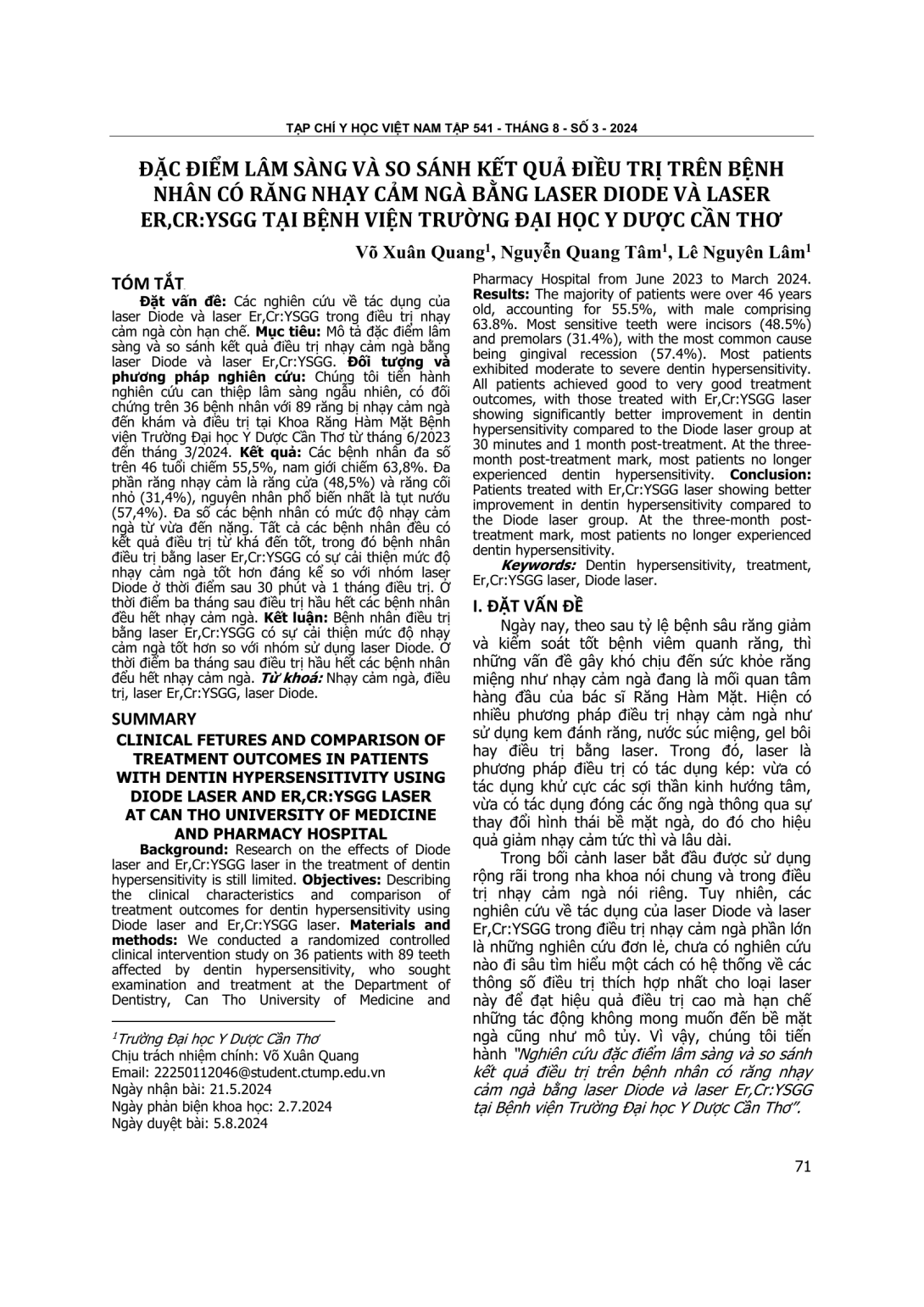
Các nghiên cứu về tác dụng của laser Diode và laser Er,Cr:YSGG trong điều trị nhạy cảm ngà còn hạn chế. Mục tiêu: Mô tả đặc điểm lâm sàng và so sánh kết quả điều trị nhạy cảm ngà bằng laser Diode và laser Er,Cr:YSGG. Đối tượng và phương pháp nghiên cứu: Chúng tôi tiến hành nghiên cứu can thiệp lâm sàng ngẫu nhiên, có đối chứng trên 36 bệnh nhân với 89 răng bị nhạy cảm ngà đến khám và điều trị tại Khoa Răng Hàm Mặt Bệnh viện Trường Đại học Y Dược Cần Thơ từ tháng 6/2023 đến tháng 3/2024. Kết quả: Các bệnh nhân đa số trên 46 tuổi chiếm 55,5%, nam giới chiếm 63,8%. Đa phần răng nhạy cảm là răng cửa (48,5%) và răng cối nhỏ (31,4%), nguyên nhân phổ biến nhất là tụt nướu (57,4%). Đa số các bệnh nhân có mức độ nhạy cảm ngà từ vừa đến nặng. Tất cả các bệnh nhân đều có kết quả điều trị từ khá đến tốt, trong đó bệnh nhân điều trị bằng laser Er,Cr:YSGG có sự cải thiện mức độ nhạy cảm ngà tốt hơn đáng kể so với nhóm laser Diode ở thời điểm sau 30 phút và 1 tháng điều trị. Ở thời điểm ba tháng sau điều trị hầu hết các bệnh nhân đều hết nhạy cảm ngà. Kết luận: Bệnh nhân điều trị bằng laser Er,Cr:YSGG có sự cải thiện mức độ nhạy cảm ngà tốt hơn so với nhóm sử dụng laser Diode. Ở thời điểm ba tháng sau điều trị hầu hết các bệnh nhân đểu hết nhạy cảm ngà.
Research on the effects of Diode laser and Er,Cr:YSGG laser in the treatment of dentin hypersensitivity is still limited. Objectives: Describing the clinical characteristics and comparison of treatment outcomes for dentin hypersensitivity using Diode laser and Er,Cr:YSGG laser. Materials and methods: We conducted a randomized controlled clinical intervention study on 36 patients with 89 teeth affected by dentin hypersensitivity, who sought examination and treatment at the Department of Dentistry, Can Tho University of Medicine and Pharmacy Hospital from June 2023 to March 2024. Results: The majority of patients were over 46 years old, accounting for 55.5%, with male comprising 63.8%. Most sensitive teeth were incisors (48.5%) and premolars (31.4%), with the most common cause being gingival recession (57.4%). Most patients exhibited moderate to severe dentin hypersensitivity. All patients achieved good to very good treatment outcomes, with those treated with Er,Cr:YSGG laser showing significantly better improvement in dentin hypersensitivity compared to the Diode laser group at 30 minutes and 1 month post-treatment. At the three-month post-treatment mark, most patients no longer experienced dentin hypersensitivity. Conclusion: Patients treated with Er,Cr:YSGG laser showing better improvement in dentin hypersensitivity compared to the Diode laser group. At the three-month post-treatment mark, most patients no longer experienced dentin hypersensitivity.
- Đăng nhập để gửi ý kiến
